The Mt Albert town centre upgrade is well on the way, causing distress to business owners and frustration to locals. Unfortunately, that’s the nature of big projects in a developing city. But by the end of the summer the hassles should be over – the end, as BRUCE MORRIS writes, of a very long and winding road.
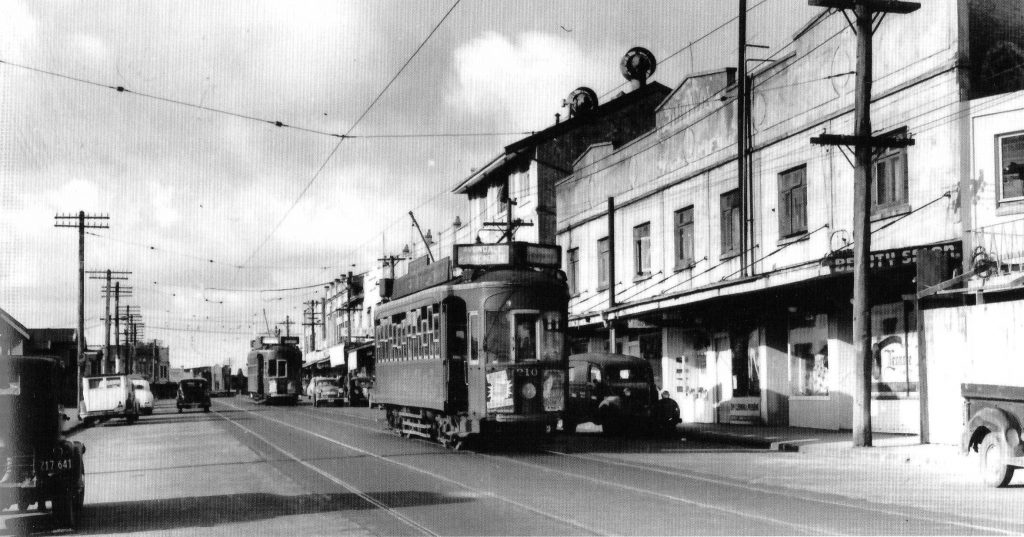
The village pictured in 1955. Image from Graham Stewart collection
[Written June 2017]
TALK to any Mt Albertian who was around in the 1950s, 60s and even the 70s and the view will be near unanimous: the village in those days was terrific.
It was the centre of retail action, with three butchers, two chemists, two fruit shops, three grocers, a haberdashery and men’s and women’s clothing shops. Not to mention a paint shop, home appliance store, hardware operator, home cookery and electrical repair business.
So what happened? How did we lose all that – nicely-kept shops where business owners were proud of what they had to offer – to end up with a slightly shabby patchwork of food joints with the odd bright spot here and there?
Well, you could blame progress.
The concept of shopping malls was making an impression around the world and in the late 60s the movement came to Mt Albert. New Lynn’s Lynmall, opened in 1963, was New Zealand’s first mall and St Lukes followed in 1971.
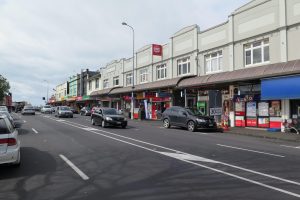 The lure of all that rating revenue was a spur to the Mt Albert Borough Council, which reasonably considered the village shopping centre would never be other than a string of shops with nowhere to stretch out.
The lure of all that rating revenue was a spur to the Mt Albert Borough Council, which reasonably considered the village shopping centre would never be other than a string of shops with nowhere to stretch out.
And, as former deputy mayor Alice Wylie noted in Deborah Dunsford’s Mt Albert Then and Now, the council recognised that the days of small village shopping centres were numbered. The mall development was coming – and “whether we said yay or nay, it was coming”, says Alice.
It didn’t take long for the village strip to start declining as locals enjoyed a more convenient way of shopping at St Lukes. Inevitably, fewer customers in the town centre meant traditional businesses shut up shop through the 80s and 90s, opening the way over the last 15 years or so to a new-look town centre that turned its back on the retail mix of the golden days.
And it was a look most locals weren’t much taken by. Gone were the butchers, supermarkets and fruit and vege shops and in their place came takeaway bars, Asian restaurants, gaming lounges and liquor stores fitted around real estate agencies, banks and professional offices.
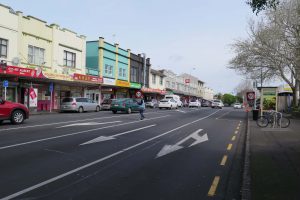 The change, over less than a decade, made the strip somehow less inviting, unless a tasty Asian meal was on your mind. A new breed of off-shore landlords didn’t help and the sense of retail pride that locals found appealing up until the 80s was replaced by a different sort of attitude.
The change, over less than a decade, made the strip somehow less inviting, unless a tasty Asian meal was on your mind. A new breed of off-shore landlords didn’t help and the sense of retail pride that locals found appealing up until the 80s was replaced by a different sort of attitude.
The result: a run-down look that earned the wrong sort of headlines.
Stephen Hart, publisher of Where to Live in Auckland, lamented in 2008: “Mt Albert will eventually become the next Mt Eden. It has all the assets in a residential and community sense, but the shopping strip is appalling. It’s a tragedy really.”
Well before he uttered those words, things were happening behind the scenes. But they were happening slowly, mired in local authority budgets and caught in a global downturn.
Graeme Easte, a city councillor from 2007-2010 and a member of the Albert Eden Local Board, says: “The council realised that the Mt Albert town centre was in a bit of a parlous state after key retailers left and food bars and the like took their place. There certainly was the strong feeling that action was needed.”
The action began in a quiet way with funding for a $5 million facelift for the village strip included in the council 10-year-plan, set in 2005 – effectively fixing a maximum deadline of 2015 for the completion of the project.
 Initial scoping plans zeroed in on retaining old buildings with architectural significance, keeping the old post office (housing Triniti of Silver and the then-souvenir shop – now Albert’s Post) as a focus of open space, replacing the station underpass with a pedestrian bridge, upgrading footpaths and vehicle lanes on New North Rd and Carrington Rd, with greenery to lift appeal, and boosting the carpark behind ASB Bank.
Initial scoping plans zeroed in on retaining old buildings with architectural significance, keeping the old post office (housing Triniti of Silver and the then-souvenir shop – now Albert’s Post) as a focus of open space, replacing the station underpass with a pedestrian bridge, upgrading footpaths and vehicle lanes on New North Rd and Carrington Rd, with greenery to lift appeal, and boosting the carpark behind ASB Bank.
So far, so good – and there was early optimism that things could get rolling by 2008 or 2009, hopefully to run hand in hand with the upgrade of the railway station.
But there was the inevitable pushing and shoving, and then along came the Government proposal for a Supercity, producing a super council from Wellsford to Pukekohe and creating a hiatus in the lead-up to the arrival of Auckland City and for a little while later.
Meanwhile the station upgrade and line electrification kept to its own shifting deadline. So much for perfect synergies.
Fortunately the $5m budget, under the heading of a “legacy project”, remained in the long term plan under the new council. But it took some resolve from the Albert Eden Local Board to keep it safe from the pressure of new spending initiatives across the city.
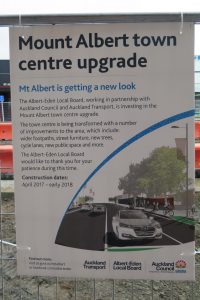 Before informal ideas and draft plans could be put before the community, council officers were quietly negotiating to free up the leases covering the carpark next to the existing Ray White operation and the building down to Ballast Lane.
Before informal ideas and draft plans could be put before the community, council officers were quietly negotiating to free up the leases covering the carpark next to the existing Ray White operation and the building down to Ballast Lane.
They were successful, except for the carpark, which was the central objective of the exercise. The plan to turn the carpark into a small, inviting park – a town square – connecting the station with the village failed at a legal hurdle when the existing leaseholder stood his ground, demanding a price that would well and truly have blown the budget.
In September 2017, the leaseholder yielded his position… but not before other sub leases were in place. As it stands, the lease over the carpark expires in 2022 and the council – with the local board nipping at its heels – will then take control.
It all comes down to money, of course, but locals hope the original plan can then start to form the “town square” that was always a key element in the project.
The footbridge from the station to the carpark (opened in September 2016) was another unfortunate hiccup. Initially, it was to be absorbed as part of the railway upgrade and would therefore fall outside the $5m overall village upgrade budget. But the deal was it had to be part of the work at the station, and because of the leasehold issues the council wasn’t able to satisfy that condition.
The local board was left to pick up the pieces and forced to spend over $1m (later reduced to about $600,000 through a subsidy) from a different funding pool, eating into its ability to handle other important work.
 As the irritants were being dealt with, planners unveiled the masterplan (minus the town square park) and showed their hand in 2015 before public meetings, in newspaper displays and through online links, refining their thoughts as the community offered its views.
As the irritants were being dealt with, planners unveiled the masterplan (minus the town square park) and showed their hand in 2015 before public meetings, in newspaper displays and through online links, refining their thoughts as the community offered its views.
The consultation round showed 94 per cent of those who responded supported the plan. The lack of cycling lanes on New North Rd and Carrington Rd drew most objections – showing the strength of the Auckland-wide cycling lobby – and they produced an amendment to include continuous cycle lanes through the full length of the town centre.
That was hardly the end of things.
When businesses discovered some carparks would disappear (the count shifted around, but the final result produced 99 car spaces against the original 123; when other locals didn’t like the idea of losing the slipway on the ANZ edge of New North Rd and Mt Albert Rd; when some didn’t like the way the cycling community was having such a strong sway; when car owners found there would be only one straight-through lane heading east over the Carrington railway bridge… the list went on.
The mood of the community was hardly encouraged when, with no notice, a plan change in late 2016 showed the removal of the right-hand turn into Mt Albert Rd for city-bound traffic using New North Rd.
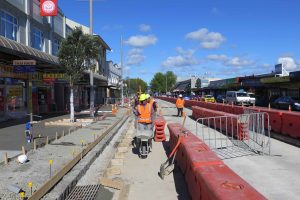 That caused merry hell (and more public meetings and more arguing over old ground) as locals feared quiet streets would be turned into rat runs by motorists trying to find a way around the no-right-hand-turn barrier.
That caused merry hell (and more public meetings and more arguing over old ground) as locals feared quiet streets would be turned into rat runs by motorists trying to find a way around the no-right-hand-turn barrier.
In the end, it was all resolved, though not to the total satisfaction of everyone. The right-hand turn would stay, although there remained concern at the likely bottleneck on the Carrington Rd bridge as east-bound traffic is restricted to one through-lane (the right-hand lane becomes right-turn-only). Time will tell.
The raised voices will probably always be with us, and Auckland Transport – with its eye on the future and an emphasis on bikes, buses and trains rather than cars and trucks – may not have covered itself with glory.
But with a project of this size and with its constrained nature (after all, you can’t pick up all the shops along one side and shift them 20m away from the road), it’s impossible to please all the people all of the time. And virtually everyone agrees the village could not have been left as it was, wasting away.
Mt Albert won’t get a silk purse out of its sow’s ear, but however it turns out will surely be better than the decaying strip that had become a blot on the local landscape.
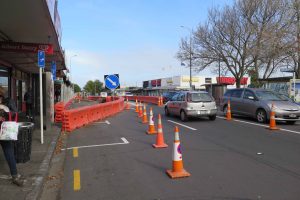 If all goes well, Mt Albert will get real change, to add to the arrival of a handful of smart new businesses that started to turn heads in 2015 and 2016.
If all goes well, Mt Albert will get real change, to add to the arrival of a handful of smart new businesses that started to turn heads in 2015 and 2016.
“Build it and they will come” is the broad thinking at the heart of the upgrade, and most people hope that will be so, especially the retailers who have been seriously hurt
From 2018, as the new look takes final shape, shop owners and landlords may be encouraged by more pleasant surrounds to spruce up their acts; and developers heartened by a new vitality may be drawn to further breathe life into a town centre that otherwise may have died.
Where we now have some run-down premises, we could in the future find medium-rise developments (the Unitary Plan allows for four-to-eight storeys in town centres – logically with shops below and apartments and perhaps offices above) and a more appealing retail and food mix.
That change will not be to all tastes, but the city’s population is racing away and we’ve got to fit everyone in.
We can’t go back to where things were in the 50s and 60s and, come 2025 or 2030, many of us may rather like the direction we’ve taken.
The shape of the upgrade plan
The town centre upgrade began on April 17, 2017, and is expected to be completed by February 2018. The project allows for:
- More trees, landscaped garden areas and a pocket park on the corner of Mt Albert and New North Roads. [During the first stage of the upgrade, some of the mature original trees were removed, but they were undistinguished and their roots, forcing their way through the surface, were a menace. New trees will be planted in deep concrete-lined trenches, preventing roots from pushing their way through footpaths.]
- Better lighting and signage.
- A wider, consistent footpath width through the town centre with new street furniture, and drinking fountains. This requires the removal of the previous slip road (and parking) in front of the shops on the railway side of New North Rd, between the Ray White building and Ballast Lane).
- A new pedestrian crossing (near the carpark by the tennis club).
- A raised cycleway, new cycle racks and improved connections through the town centre.
- More bus shelters, seating and a wider footpath improving connections between bus and rail, including the Outer Link to the Western Line.
- Better pedestrian access routes to the Mt Albert train station through new signage and wider footpaths.
- Better management of stormwater run-off through increased planting and landscape design.
Upgrade benefits (as seen by Auckland Transport, an arm of Auckland Council)
- A safer, more appealing environment for pedestrians, cyclists, commuters, road users and retail and restaurant businesses.
- More places to pause and rest and enjoy.
- A wider footpath allows for more street activities and gives greater opportunity for on-street dining and arts and culture.
- A greener, more attractive environment that retains on-street parking wherever possible.
- An environment that reflects Māori cultural values.
And the negatives?
The council doesn’t focus on the negatives, but most of them can be summed up in two words: car parks.
At the latest count, 24 car parks will disappear (a huge disappointment to the businesses operating at the village – and a figure that slowly grew as the project took shape). But there will still be 99 parking spaces available when the upgrade is completed – many of them in the “hidden” park over the back of the ASB Bank, alongside the railway line. That area needs an upgrade, too, but it may be a little while before funds can be allocated and it gets the treatment.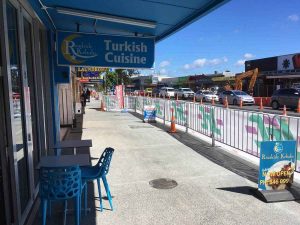
The other major disappointment is the heart of the original plan – the creation of a plaza in the parking area alongside Ray White and the overbridge to the main railway “bridge” from Carrington Rd.
This was always a central part of the plan, but had to be set aside when the council was unable to reach agreement with the businessman holding the lease over the land. The price was just too high. To some extent that obstacle has since gone, and the council now holds the lease. But some original sub leases are still in place and it will be 2022 before they expire. Perhaps then Mt Albert may get the little plaza originally planned.
But the money set aside for that part of the development has been committed elsewhere and it will need resolve and local board commitment to find a new budget for the job.
Handling the traffic flow
The removal of the right-hand turn (into Mt Albert Rd for city-bound traffic) in a late draft of the upgrade plan brought a furious response. Locals were concerned that banning the right-hand turn into a main arterial road would have a huge impact on other, smaller streets as motorists tried to navigate their way east through alternative routes.
Auckland Transport took note of the raised voices and, after further research and two public meetings called by MARA, settled on an option that kept a right-hand turn (though not in a dedicated lane) and also accommodated full-length cycle lanes.
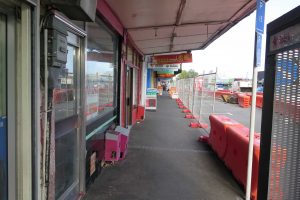 Auckland Transport notes on its website: “The traffic impacts of implementing this option will be mitigated by adjusting the traffic signals at the New North Road/Mt Albert Rd/Carrington Rd intersection as well as optimising the traffic signal phasing at the New North Road/Richardson Road intersection.
Auckland Transport notes on its website: “The traffic impacts of implementing this option will be mitigated by adjusting the traffic signals at the New North Road/Mt Albert Rd/Carrington Rd intersection as well as optimising the traffic signal phasing at the New North Road/Richardson Road intersection.
“The New North Rd, Mt Albert intersection will be carefully monitored over a period of months during and after construction. This will include traffic speeds and volumes on adjoining local streets to assess any possible impact.
“It’s possible that further mitigations may need to be considered, such as further optimisation of traffic signal phasing for different times of the day, additional signage or re-routing traffic that’s not destined for the town centre.
“Any reduction in traffic volumes through the town centre as a result of the new Waterview Connection on State Highway 20 will further assist in minimising traffic impacts.”
Time will tell on all of these things (some experts believe the Waterview link will have no impact on traffic through the village), and locals still need to be persuaded that the elimination of one of the straight-through lanes for east-bound traffic heading over the Carrington Rd bridge will help traffic flow rather than hinder it. But AT believes a change in traffic light phasing will mean there is no negative impact.
Over time, the Unitec development will put even more pressure on the village bottlenecks. But by then perhaps Aucklanders will have come to accept that the car is not all-important and that bus, rail and bike are a big part of the future.
Timeline
- August 2014 – Mt Albert town centre upgrade incorporated into the Albert-Eden 2014-2017 Local Board Plan.
- November 2015 – Public consultation on draft concept design.
- February 2016 – Auckland Council concept design formally signed-off by Albert-Eden Local Board.
- June 2016 – Auckland Council award Design and Build contract.
- July 2016 to February 2017 – Auckland Council and AT finalise detailed design in series of internal workshops, consultation with Albert-Eden Local Board, a number of external stakeholders and the public.
- December 2016 – Minor advanced enabling works; consultation on right-turn options from New North Rd into Mt Albert Rd; site inspections revealed an old concrete road layer which may need to be removed before new surfacing can be laid. If this is done, other utility providers may also want to upgrade their networks as part of the project.
- Late January 2017 – Consultation feedback analysis.
- Early February 2017 – Final decision on right-turn option.
- March 2017 – Consultation report and AT decision available online.
- 18 April 2017 – Construction starts.
- February 2018 – Mt Albert Town Centre upgrade complete.
- 2018 – Post-upgrade traffic monitoring.
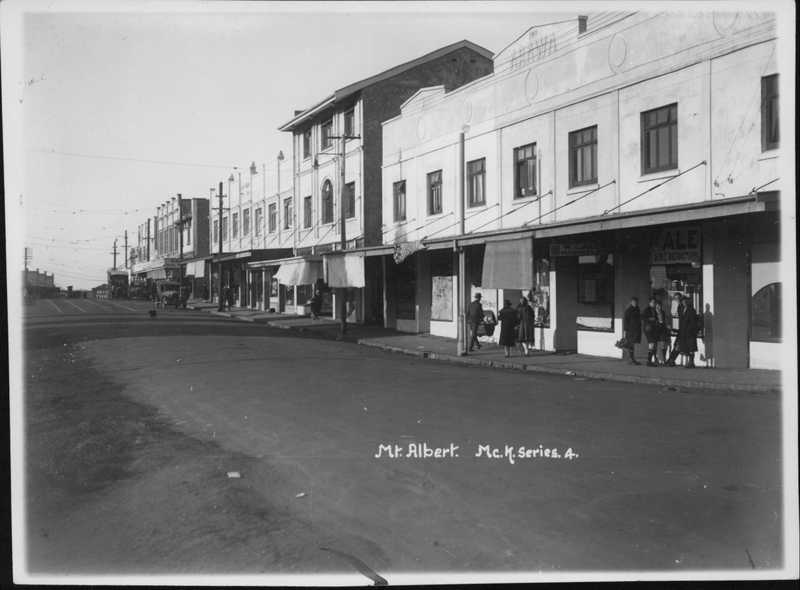
Terminus shops at Mt Albert. Picture courtesy Alexander Turnball Library
